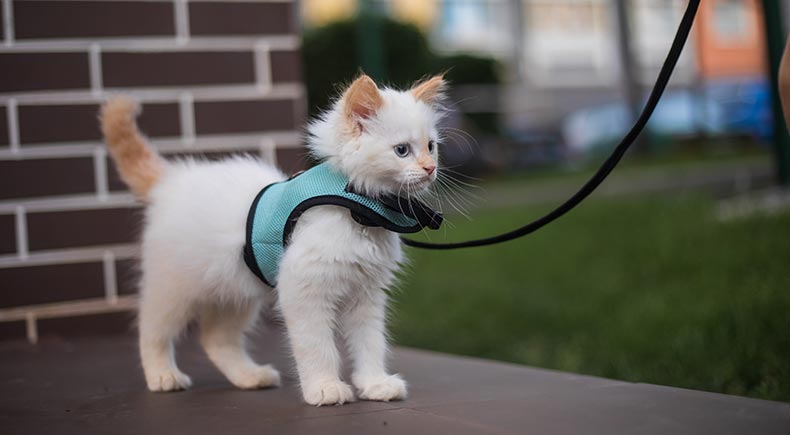Table of Contents
Leash training a cat can provide a safe and enjoyable way for your feline friend to explore the outdoors. With patience and the right approach, your cat can learn to walk on a leash comfortably. This guide offers essential tips for leash training a cat, ensuring a positive and rewarding experience for both you and your pet.

1. Choose the Right Harness and Leash
Selecting the appropriate harness and leash is crucial for successful leash training:
- Comfortable Harness: Choose a well-fitted, comfortable harness designed for cats. Avoid using a collar for leash training as it can cause injury.
- Adjustable Fit: Ensure the harness is adjustable and fits snugly without being too tight.
- Lightweight Leash: Use a lightweight leash that allows your cat to move freely.
2. Introduce the Harness Gradually
Allow your cat to get used to the harness before attempting to walk on a leash:
- Familiarization: Leave the harness near your cat’s favorite spots so they can investigate it at their own pace.
- Short Sessions: Begin with short sessions of putting the harness on indoors, gradually increasing the duration.
- Positive Reinforcement: Reward your cat with treats and praise while they wear the harness to create a positive association.
3. Practice Indoors First
Start leash training inside the house where your cat feels safe and secure:
- Attach the Leash: Attach the leash to the harness and let your cat drag it around to get used to the sensation.
- Guided Walks: Gently guide your cat with the leash, allowing them to lead the way while you follow.
- Short Sessions: Keep sessions brief and gradually increase the time as your cat becomes more comfortable.
4. Move to a Controlled Outdoor Environment
Once your cat is comfortable indoors, transition to a controlled outdoor space:
- Safe Area: Choose a quiet, enclosed area like a backyard or garden for initial outdoor training sessions.
- Supervised Exploration: Allow your cat to explore at their own pace while you supervise closely.
- Positive Experiences: Encourage positive outdoor experiences with treats, toys, and praise.
5. Gradually Increase Exposure
Slowly increase your cat’s exposure to different outdoor environments:
- New Areas: Introduce your cat to new outdoor areas gradually, ensuring each experience is positive.
- Monitor Behavior: Watch for signs of stress or fear and return to familiar areas if your cat becomes overwhelmed.
- Stay Close: Always stay close to your cat, providing reassurance and guidance.
6. Use Positive Reinforcement
Positive reinforcement is key to successful leash training:
- Treats and Praise: Reward your cat with treats and praise for calm and cooperative behavior on the leash.
- Consistent Rewards: Be consistent with rewards to reinforce desired behaviors.
- Patience: Be patient and give your cat time to adjust to the new experience.
7. Be Mindful of Safety
Ensure your cat’s safety during leash training sessions:
- Check Harness Fit: Regularly check the harness fit to ensure it remains secure and comfortable.
- Avoid Crowded Areas: Stay away from crowded or noisy areas that might frighten your cat.
- Stay Alert: Be aware of your surroundings and potential hazards like traffic, other animals, and toxic plants.
Conclusion on Tips for Leash Training a Cat
Leash training a cat requires patience, consistency, and positive reinforcement. By choosing the right harness and leash, introducing the harness gradually, practicing indoors first, moving to a controlled outdoor environment, gradually increasing exposure, using positive reinforcement, and being mindful of safety, you can ensure a successful and enjoyable leash training experience for your feline friend. For more tips on cat training and care, visit the ASPCA and Humane Society.
FAQs on Tips for Leash Training a Cat
How long does it take to leash train a cat?
The time it takes to leash train a cat varies depending on the cat’s age, temperament, and prior experiences. Consistent training and positive reinforcement typically yield results within a few weeks to a few months.
What if my cat refuses to wear the harness?
If your cat refuses to wear the harness, introduce it gradually and make the experience positive with treats and praise. Patience and persistence are key.
Can all cats be leash trained?
While most cats can be leash trained, some may never become comfortable with it. Assess your cat’s personality and proceed at their pace.
Is it safe to use a collar for leash training a cat?
No, using a collar for leash training can cause injury to your cat. Always use a well-fitted harness designed specifically for cats.
How can I make outdoor leash training sessions enjoyable for my cat?
Bring treats, toys, and other positive reinforcements to create a pleasant experience. Allow your cat to explore at their own pace and provide plenty of praise.
What should I do if my cat becomes scared or stressed during leash training?
If your cat shows signs of fear or stress, return to a familiar environment and try again later. Keep training sessions short and positive to build confidence over time.











